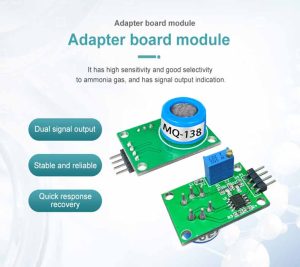-
What is a Gas Sensor: Working and Types
- Gas sensors are devices designed to detect and measure the presence of gases in the environment. They play a crucial role in various industries and applications, from ensuring safety in hazardous environments to monitoring air quality. In……
- Chat Online
-
Description
Gas sensors are devices designed to detect and measure the presence of gases in the environment. They play a crucial role in various industries and applications, from ensuring safety in hazardous environments to monitoring air quality. In this article, we will explore what gas sensors are, how they work, and the different types available.

Introduction
Gas sensors are electronic devices that detect and measure the concentration of gases in the air or other environments. They are used in a wide range of applications, such as industrial processes, environmental monitoring, and safety systems. Gas sensors are essential for preventing accidents, minimizing environmental damage, and ensuring the well-being of individuals.
Working Principle
Gas sensors work based on various principles, but the most common one is the use of chemical reactions. These reactions occur between the gas molecules and a sensing element within the sensor. When the target gas comes into contact with the sensing element, it triggers a reaction that produces an electrical signal. This signal is then converted into a readable value that corresponds to the gas concentration.
Types of Gas Sensors
3.1 Catalytic Gas Sensors
Catalytic gas sensors are commonly used to detect flammable gases. They contain a catalyst that promotes the oxidation of the target gas. When the gas comes into contact with the catalyst, it reacts and produces heat. This heat change is then measured and used to determine the gas concentration.
3.2 Electrochemical Gas Sensors
Electrochemical gas sensors are widely used for detecting toxic gases like carbon monoxide (CO) and nitrogen dioxide (NO2). These sensors consist of electrodes immersed in an electrolyte solution. When the target gas enters the sensor, it causes a chemical reaction at the electrodes, generating an electrical current. The magnitude of this current is proportional to the gas concentration.
3.3 Infrared Gas Sensors
Infrared gas sensors are employed to detect various gases, including carbon dioxide (CO2), methane (CH4), and propane (C3H8). These sensors use infrared light to detect the presence of gas molecules. Each gas molecule absorbs a specific wavelength of infrared light, and by measuring the amount of light absorbed, the sensor can determine the gas concentration.
3.4 Photoionization Detectors (PID)
PID sensors are used to detect volatile organic compounds (VOCs) and other hazardous gases. They work by ionizing gas molecules using ultraviolet light. The ionized molecules create a measurable electrical current that corresponds to the gas concentration. PID sensors are highly sensitive and can detect gases at very low levels.
3.5 Metal Oxide Semiconductor (MOS) Gas Sensors
MOS gas sensors are effective in detecting a range of gases, including carbon monoxide (CO), methane (CH4), and hydrogen (H2). These sensors consist of a heating element and a metal oxide semiconductor material. When the target gas interacts with the sensing material, it changes the electrical conductivity of the sensor. This change in conductivity is then measured and used to determine the gas concentration.
Gas sensors find applications in various industries, including:
Industrial: Gas sensors are used in manufacturing plants to detect leaks or monitor gas emissions. They ensure worker safety and help prevent industrial accidents.
Environmental Monitoring:
Gas sensors play a crucial role in monitoring air quality, detecting pollutants, and ensuring compliance with environmental regulations.
Automotive:
Gas sensors are used in vehicles to monitor the exhaust gas composition. They help control emissions and ensure compliance with emission standards.
Medical:
Gas sensors are utilized in medical devices to monitor gas levels during anesthesia or assess breath acetone levels, which can indicate diabetes.
Residential:
Gas sensors are installed in homes to detect the presence of carbon monoxide, natural gas, or propane, providing an early warning of potential dangers.

Conclusion
Gas sensors are essential devices that enable the detection and measurement of gases in various environments. They operate based on chemical reactions, converting gas concentration into measurable electrical signals. With different types of gas sensors available, such as catalytic, electrochemical, infrared, PID, and MOS sensors, various gases can be detected with high accuracy. Gas sensors play a vital role in ensuring safety, environmental monitoring, and compliance in numerous industries and applications.
-
Recommend:
-
-
Gas detectors are crucial devices used in various industrie…
-
How do gas detectors ensure industrial safety?
Gas detectors play a crucial role in ensuring the safety of…
-
How Gas Sensors Help Combat Air Pollution?
Air pollution is a pressing global issue that poses signifi…
-
How can gas sensors be used in air quality monitoring?
Air pollution is a significant global concern that affects …
-
 : +86 155 8830 2704
: +86 155 8830 2704 : jxdziot@gmail.com
: jxdziot@gmail.com
